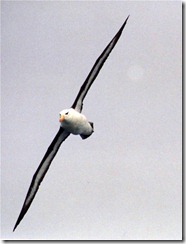Albatrosses in the South Atlantic with cameras on their backs apparently used killer whales to find food. The cameras were attached to four black-browed albatrosses from Bird Island and their treks for food were monitored. The cameras were set to take pictures every 30 seconds. From these cameras the researchers noticed that the birds used large marine mammals that were feeding to find their own food. The researchers conducting the study were from the British Atlantic Survey or BAS, the National Institute of Polar Research, and Japan’s Hokkaido University. The researchers had to endure thousands of “nothing” pictures from the small cameras on the albatrosses’ backs until they came across a piece of gold. A picture documenting a few birds in front of the one with the camera and a clear picture of a killer whale.
Dr. Richard Phillips, a seabird ecologist from BAS, says the pictures “show us that albatrosses associate with marine mammals in the same way as tropical seabirds often do with tuna or dolphins. In both cases the prey – usually fish – are directed to the surface by the marine mammals and then it’s easy hunting for the birds.”
The purpose of the research was not conservation driven, but to learn more about albatrosses every day life and foraging habits. Sadly, due to long-line fishing techniques about 100,000 albatrosses die yearly. Albatrosses feed on fish like the Patagonian toothfish, which is a deeper-water fish. The researchers suspect that whales drive the fish to the surface and the birds take advantage of this because they can only dive up to a few meters.
A report on this research in the Public Library of Science states that “scavenging on such prey fragments may be more energetically advantageous than the pursuit and capture of live prey, as such activities can require frequent take-off, landing, and prey handling which may all be energetically costly.”
Having enough energy to feed is very important for mostly seagoing birds. Therefore, energy efficient feeding techniques are very advantageous. The foraging trips lasted between a half day and five and a half days.
Even though this research is not directed towards avian conservation, it shows that many animals act together in the wild. Even more than we may realize. It is all interconnected.
Click here for the full article.
Top picture credit to British Antarctic Survey/PA.


Leave a comment